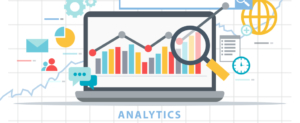3 Essential KPIs for Product Analytics

Key performance indicators, or KPIs, are used to measure various aspects of your products and the users who use them. Every company has business objectives and needs accurate data to measure where they are successful and where they’ve fallen short.
Kissmetrics breaks down what KPIs are, how to choose the right ones for your company, the top metrics to track, and how you can leverage the information they provide.
What is a KPI?
A KPI is any quantifiable method of evaluating a product, service, user, employee, or business. In order to evaluate your current KPIs, you need to track multiple metrics. Metrics are objective measurements (i.e. data) of certain aspects of your business like revenue and churn that you can meaningfully compare against other results. So KPIs are the indicators aligned with your business objectives (i.e. the big broad idea) and metrics are the smaller components (i.e. the details) that add up to the KPIs.
You can use metrics to monitor your KPIs and see whether your current strategies are successful. Metrics can measure anything, but KPIs measure your success.
How is KPI Calculated?
Robust product analytics tools like Kissmetrics calculate your KPIs for you. All you need to do is enter your parameters, set up your event tracking and wait for the data to come in.
When checking to see how your business’s progress is matching up against your targets, the real-time data from KPIs are plugged into a simple formula. Your current KPI value minus the baseline divided by your target minus the baseline.
Tracking KPIs in real-time lets your teams react on the spot to effective or not-so effective strategies by watching their progress.
How do I Know Which KPIs to Track?
Choosing the right KPIs for your company can take multiple steps. You want enough information to get a complete picture of your users and what they value in your products, and you don’t want to be bombarded with numbers and graphs that don’t mean anything.
Depending on your industry, some KPIs may stand out as more essential than others. However, some KPIs are always relevant, and we’ll be addressing those below.
What are 3 Essential KPIs for Product Analysis?
While there are many different KPIs available, this article will cover three of the essential KPIs for product analysis. Depending on your company’s industry and the types of products or services on offer, these KPIs may be tweaked or swapped out to achieve your business goals.
Monthly Recurring Revenue
One of the basic measurements is monthly recurring revenue or MRR. It determines how much money your business brings in monthly by totaling the amounts from goods and services sold. It’s an essential KPI for SaaS companies offering subscriptions to see if customers are returning or churning.
Revenue doesn’t take expenses into account, but it does give you information about whether your product is selling.
Customer Acquisition Cost
Customer acquisition cost (CAC) measures how much money your company spends to attract a new user. Most businesses find that attracting new users is more expensive than retaining existing users, but if you want your business to grow, you’ll need to broaden your user base.
This metric incorporates costs from advertisements, employing a marketing team, employing a sales team, and any additional creative costs. To understand the budget for your customer acquisition costs, you’ll need to calculate the following KPI: customer lifetime value.
Customer Lifetime Value
Customer lifetime value, or CLV, estimates how much a single customer will contribute financially to your company throughout their purchasing life. In an ideal world, your product or service would be something that a customer would go on buying for the rest of their life. Since that rarely happens, CLV calculates how long the customer is expected, on average, to buy your product.
This KPI demonstrates the average amount of spending from one customer prior to ending their subscription or discontinuing their business. It directly ties in to the customer acquisition costs because if you know what a single customer is projected to contribute, you can calculate the maximum amount of CAC while still retaining a profit.
What are Common Biases I Should Look Out for When Measuring KPIs?
It’s important to remember that KPIs are only as valuable as your interpretations of the data. Humans are complicated beings, and their behavior is difficult to simplify into nice, concrete numbers. That’s why it’s essential to account for common biases when your company releases a new product or service.
Early Adopters
One bias to watch out for when you release a new version or product is that of the early adopters. Early adopters are often people who are devoted to your company and have committed to snapping up everything you put out.
While these users are a valuable part of your user base, their enthusiasm can throw off your measurements.
Since you can’t base your assumptions about most of your users around the loyalty of your top fans, you will need to measure how soon users begin adopting your update or separate old users from new users.
Novelty
People love new things, right? When you release the latest and greatest gadget or feature, plenty of people will flock to the new technology. As a result, your KPIs for the first few days or weeks will likely skyrocket with a new release but then take a sharp dip immediately after. That doesn’t mean that people suddenly dislike your product.
Humans are naturally curious, and many will try something just to see what it is. But, unfortunately, that doesn’t tell you anything about whether or not they value the enhancements to your product.
Some find the new product or feature valuable enough to incorporate into their lives, but most enjoy the novelty and then forget about it when the next big thing hits the shelves.
Default Settings
You may have noticed many users tend to stick with default settings. Accordingly, if you implement different default settings, your KPIs might show how users interact with your product in new ways.
Default settings can be a good thing and a bad thing. Giving users automatic options to interact with your products may be the inspiration they need to see how the product adds value to their lives. Alternatively, they may not like the default settings and stop using the product altogether.
When you give users a default, instead of allowing customization from the get-go, you’ll notice that many users either don’t know enough to change their settings to other options or don’t want to put in the effort. Don’t let your KPIs trick you into thinking that people have suddenly changed how they use your product, though.
How Can I Reach My KPI Targets?
Your company’s KPI targets may need to be adjusted to incorporate realistic expectations depending on your industry. However, by continually measuring your KPIs, you can understand what your users want and modify your products to reach those goals. KPIs are constantly in flux because your company is growing and changing to meet customer demands.
It’s also important to note that not every KPI will be successful. Ideally, you’d meet and exceed all of your goals, but sometimes that isn’t the case. If you are having trouble meeting a KPI, that’s an area for you to hone in on and look for ways to improve. What’s stopping you from reaching the target? Is it something within your control?
How Can Tracking KPIs Make My Product Better?
KPIs provide relevant insights for companies to improve their products by measuring how well your brand is living up to your goals. When you create realistic KPIs, you can watch to see if your actions are pushing you closer to success by achieving your KPIs, how quickly you’re succeeding, or if you need to rethink your strategies.
With the real-time information about your success in tracked initiatives, you can make data-driven decisions to benefit your company and make your product better. Plus, you can ensure that your product continues to improve by setting and updating benchmarks so you never become stagnant.
Tracking KPIs also helps you find areas in need of improvement so that you can make those fixes for an overall better product.
Conclusion
Knowing which KPIs to monitor is a crucial part of achieving your business goals. While all quantifiable metrics provide information, it’s essential to choose measurements that you can leverage to add value to your company. Otherwise, the data pouring in can become overwhelming and worthless.
Visit Kissmetrics for more information on measuring KPIs to reach your business goals.
Sources:
The Role of Analytics | SVPG.com
Feb 22, 2019, 15 Key Product Management Metrics and KPIs | Altexsoft.com
Customer Acquisition Cost: How to Calculate, Reduce & Improve It | Neilpatel.com


